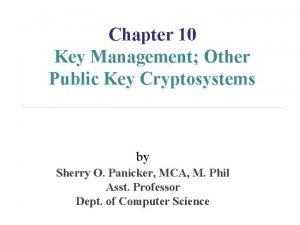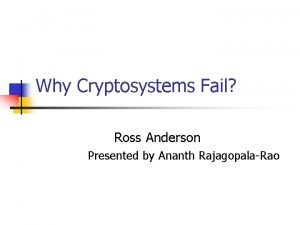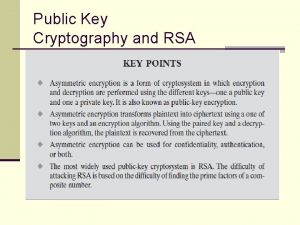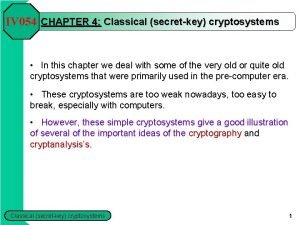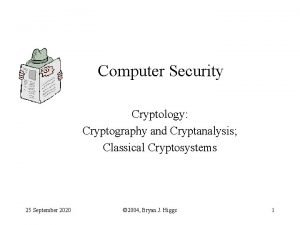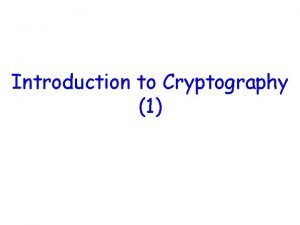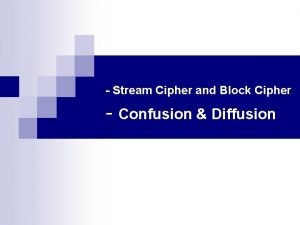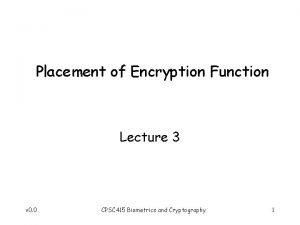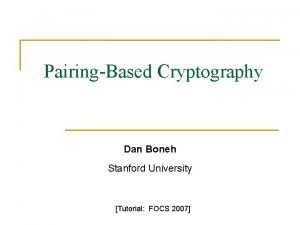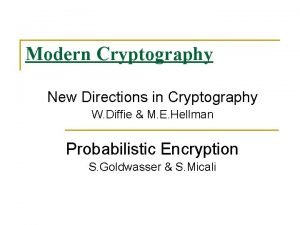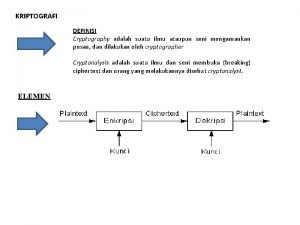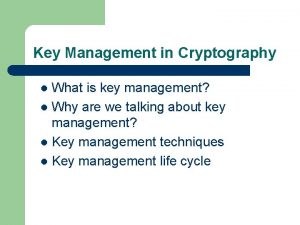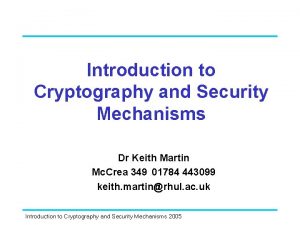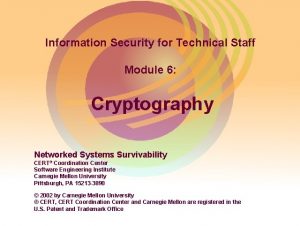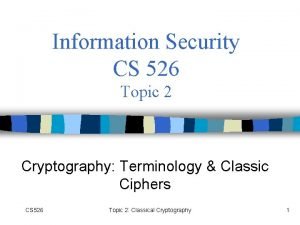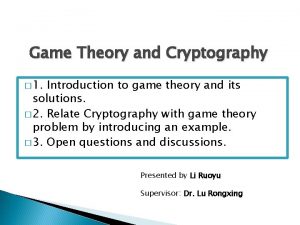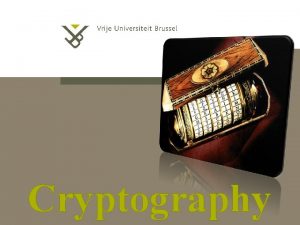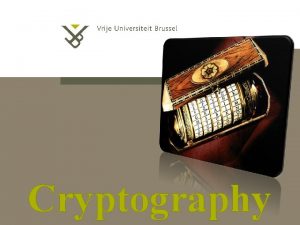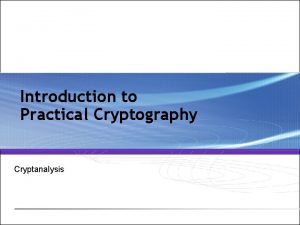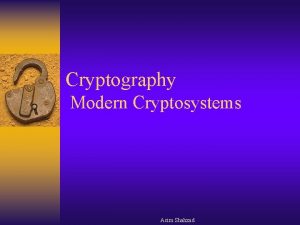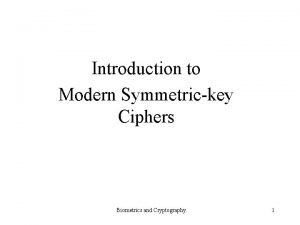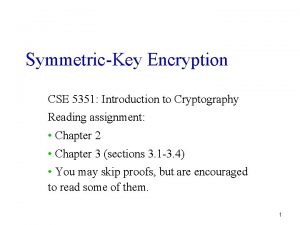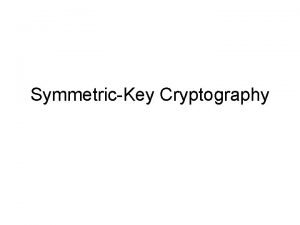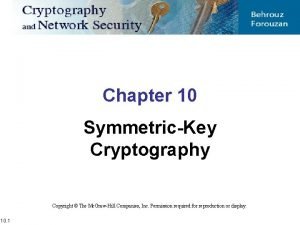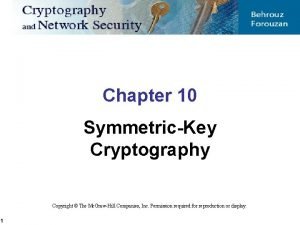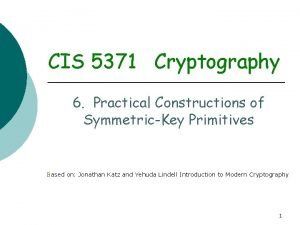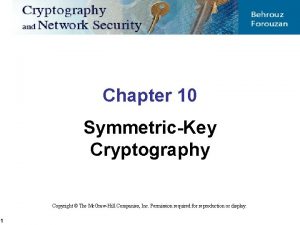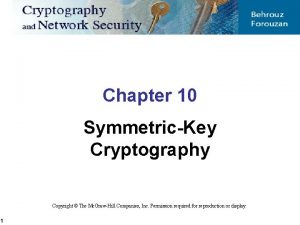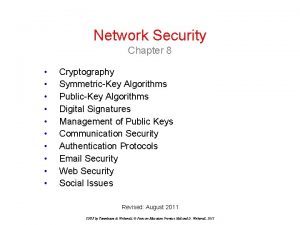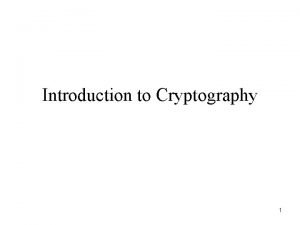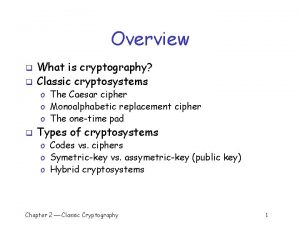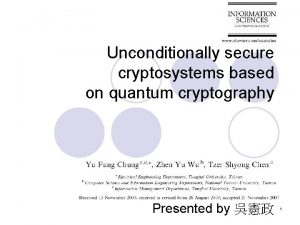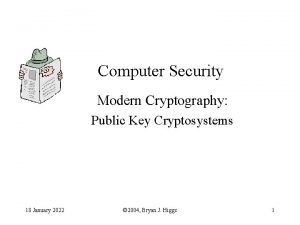Introduction to Cryptography What is cryptography Symmetrickey cryptosystems





























- Slides: 29

Introduction to Cryptography • What is cryptography? • Symmetric-key cryptosystems – – The Caesar cipher Monoalphabetic replacement cipher The one-time pad DES/AES • Asymmetric-key (public key) cryptosystems – RSA

What is Cryptography? • Cryptography is the science of designing and analyzing cryptosystems which are used to disguise messages so that only certain people can see through the disguise • A classic cryptosystem: the Caesar cipher – – Replace every ‘A’ in the message with a ‘D’ Replace every ‘B’ in the message with a ‘E’ Replace every ‘C’ in the message with a ‘F’ Etc.

The Caesar Cipher • Camouflage the message “ATTACK AT DAWN” by writing “DWWDFN DW GDZQ” • “ATTACK AT DAWN” is called the plaintext • “DWWDFN DW GDZQ” is called the ciphertext • Encryption is the process used to convert plaintext into ciphertext • Decryption is the process used to convert ciphertext into plaintext

The Key to a Cryptosystem • Assumptions: – – – Encryption and decryption algorithms are public Their results depend on some value known as a key Protection is based solely on the secrecy of the key Encryption for the Caesar cipher = “shift forward by n” Decryption for the Caesar cipher = “shift backwards by n” – The key for the Caesar cipher is n • Encryption: Ci = (Pi + n) mod 26 • Decryption: Pi = (Ci - n) mod 26

The Keyspace for a Cryptosystem • For the Caesar cipher, any value from the set {1, 2, …, 25} can be a key • The set of usable keys is referred to as a cryptosystem’s keyspace • Cryptosystems with a small keyspace are vulnerable to a brute-force search for the proper key

What is Cryptanalysis? • Cryptanalysis is the science of attacking cryptosystems – Deduce the key and/or recover the plaintext • Assume adversary knows the ciphertext and encryption algorithm

Cryptanalysis of the Caesar Cipher • Ciphertext = “GRR MGAR OY JOBOJKJ OT ZNXKK VGXZY” • Perform decryption with each possible key: – Plaintext (if key is 1): FQQ LFZQ NX INANIJI NS YMWJJ UFWYX – Plaintext (if key is 2): EPP KEYP MW HMZMHIH MR XLVII TEVXW – Plaintext (if key is 3): DOO JDXO LV GLYLGHG LQ WKUHH SDUWV – Plaintext (if key is 4): CNN ICWN KU FKXKFGF KP VJTGG RCTVU – Plaintext (if key is 5): BMM HBVM JT EJWJEFE JO UISFF QBSUT – Plaintext (if key is 6): ALL GAUL IS DIVIDED IN THREE PARTS – Plaintext (if key is 7): ZKK FZTK HR CHUHCDC HM SGQDD OZQSR. . . – Plaintext (if key is 26): GRR MGAR OY JOBOJKJ OT ZNXKK VGXZY • Only one of the plaintexts above (the one corresponding to a key of 6) makes sense

The Monoalphabetic Replacement Cipher • Similar to the Caesar cipher but with much larger keyspace • A key is any permutation of the 26 letters of the alphabet – Example: JQPLMZKOWHANXIEURYTGSFDVCB • Defines a cipher alphabet: A B C D E F G H I J K L MN O P Q R S T U VWX Y Z J Q P L M Z K OWH A N X I E U R Y T G S F D V C B

The Monoalphabetic Replacement Cipher - Encryption • Plaintext (by Thomas Jefferson): – “I prefer freedom with danger to slavery with ease. ” • Cipher alphabet A B C D E F G H I J K L MN O P Q R S T U VWX Y Z J Q P L M Z K OWH A N X I E U R Y T G S F D V C B • Encryption: replace each plaintext letter with the corresponding cipher letter from the cipher alphabet • Examples: – – Replace every “A” in the plaintext with a “J” Replace every “B” in the plaintext with a “Q” Replace every “C” in the plaintext with a “P” Etc.

The Monoalphabetic Replacement Cipher – Encryption (cont) • Plaintext: – “I prefer freedom with danger to slavery with ease. ” • Cipher alphabet: A B C D E F G H I J K L MN O P Q R S T U VWX Y Z J Q P L M Z K OWH A N X I E U R Y T G S F D V C B • Ciphertext: – “W uymzmy zymmlex dwgo ljikmy ge tnjfmyc dwgo mjtm. ”

The Monoalphabetic Replacement Cipher - Decryption • Ciphertext: – “W uymzmy zymmlex dwgo ljikmy ge tnjfmyc dwgo mjtm. ” • Cipher alphabet A B C D E F G H I J K L MN O P Q R S T U VWX Y Z J Q P L M Z K OWH A N X I E U R Y T G S F D V C B • Decryption: replace each plaintext letter with the corresponding cipher letter from the cipher alphabet • Plaintext: – “I prefer freedom with danger to slavery with ease. ”

The Monoalphabetic Replacement Cipher - Keyspace • Key = any permutation of the 26 letters of the alphabet • Keyspace contains 26! elements – 403, 291, 461, 126, 605, 635, 584, 000 • Exhaustive search at one trillion keys per second takes: – 400 trillion seconds – More than 12 million years • It is fairly easy to perform cryptanalysis on this cipher, but not using exhaustive search

The Monoalphabetic Replacement Cipher – Weak Keys • Some keys result in better-disguised ciphertext than others: – Using JQPLMZKOWHANXIEURYTGSFDVCB as a key gives: “W uymzmy zymmlex dwgo ljikmy ge tnjfmyc dwgo mjtm. ” – Using ABCDEFGHIJKLMNOPQRSTUVWXYZ as a key gives: “I prefer freedom with danger to slavery with ease. ” – Using ABCDEFGHIJKLMNOPQRSTUVWXZY as a key gives: “I prefer freedom with danger to slaverz with ease. ” • Keys that produce weak ciphertext are called weak keys • Weak keys need not be a problem so long as: – They are not used – The vast majority of the keys are not weak

One-Time Pads • An unbreakable encryption scheme • Sender and receiver must generate a large, non-repeating set of truly random key letters – E. g. IPKLPSFHGQYPWKQMSVCX… • Sender uses each key letter on the pad to encrypt one letter of plaintext – Ci = (Pi + Ki) mod 26 • Receiver uses each key letter on the pad to decrypt one letter of ciphertext – Pi = (Ci - Ki) mod 26

One-Time Pad Encryption - Example • One time pad: IPKLPSFHGQYPWKQMSVCX… • Plaintext: “ATTACKATDAWN” • Ciphertext: “JJEMSDGBKRVD” A (1) + I (9) mod 26 = J (10) T (20) + P (16) mod 26 = J (10) T (20) + K (11) mod 26 = E (5) A (1) + L (12) mod 26 = M (13) C (3) + P (16) mod 26 = S (19) K (11) + S (19) mod 26 = D (4) A (1) + F (6) mod 26 = G (7) T (20) + H (8) mod 26 = B (2) D (4) + G (7) mod 26 = K (11) A (1) + Q (17) mod 26 = R (18) W (23) + Y (25) mod 26 = V (22) N (14) + P (16) mod 26 = D (4)

One-Time Pad Decryption - Example • One time pad: IPKLPSFHGQYPWKQMSVCX… • Ciphertext: “JJEMSDGBKRVD” • Plaintext: “ATTACKATDAWN” J (10) - I (9) mod 26 = A (1) J (10) - P (16) mod 26 = T (20) E (5) - K (11) mod 26 = T (20). .

One-Time Pad - Security • Why is it an unbreakable encryption algorithm? – Assume the adversary doesn’t know any of the key letters on the one-time pad – If they were generated truly randomly then all key letters are equally likely in each position – So when the adversary sees the ciphertext, “JJEMSDGBKRVD” – All plaintexts are equally possible: JJEMSDGBKRVD = ATTACKATDAWN for IPKLPSFHGQYP JJEMSDGBKRVD = ELVISISALIVE for EXIDZUNAYIZY. .

One-Time Pad - Security (cont) • Every plaintext message is equally possible • No way for an adversary to determine which plaintext is correct • A truly random key sequence added to a nonrandom plaintext produces a truly random ciphertext • No algorithm will enable the adversary to choose the proper plaintext with better than random probability

One-Time Pads - Drawbacks • Key must be as long as the message – Okay for short or infrequent messages • Security depends on adversary never obtaining a copy of the pad – Pad must be distributed securely to sender and receiver – Pad must be destroyed immediately after use to lessen the likelihood that old messages will be compromised • Security depends on using the cryptosystem properly – Pad must be generated truly randomly (pseudo-random won’t due) – No part of the pad can ever be reused

Modern Symmetric-Key Cryptosystems • The Data Encryption Standard (DES) – Adopted in 1976 – Block size = 64 bits – Key length = 56 bits • The Advanced Encryption Standard (AES) – Adopted in 2000 – Block sizes = 128, 192, or 256 bits – Key lengths = 128, 192, or 256 bits

Other Types of Cryptosystems • Symmetric-key – Same key used for encryption and decryption – Typically used for bulk encryption • Asymmetric-key (or public-key) – Different key used for encryption and decryption – Usually not used for bulk encryption

Symmetric-key Cryptosystems • Standard use of a symmetric-key cryptosystem: – Sender and receiver agree on a secret key • Must be done securely! – Messages are encrypted by the sender with the shared key and decrypted by the receiver with the shared key – Note: Users need to have a previously-established shared secret to communicate securely

Public-Key Cryptosystems • Standard use of a public-key cryptosystem: – Generate a public-key/private-key pair • Disseminate your public key widely • Keep your private key secret – Anybody can encrypt a message to you using your public key – Only you can decrypt the message using your private key – Note: unlike symmetric-key cryptosystems, users don’t need to have a previously-established shared secret to communicate securely

Public-Key Cryptosystems (cont) • Standard use of a public-key cryptosystem: – Digital signatures - proof of authorship of a document or agreement with its contents • User encrypts a document with his private key to create a digital signature • Anybody can verify the digital signature by using the signer’s public key • Only the signer can produce his signature, and he can’t reasonably claim he didn’t sign a document bearing his signature – Note: unlike symmetric-key cryptosystems, users can create authentic, unforgable, nonreusable, nonrepudiable digital signatures

Public-Key Cryptography • Each user has a pair of keys that are inverses of each other: – The public key • Made public • Can decrypt anything encrypted with the private key – The private key • Kept secret • Can decrypt anything encrypted with the public key

Public-Key Cryptography – Requirements • Every user has a unique public/private key pair • For every message, M, decrypting (using the corresponding private key) a message encrypted with a public key yields M • Deriving the private key from the public key or the plaintext from the ciphertext is difficult • The key generation, encryption, and decryption routines must be relatively fast

The RSA Cryptosystem • Proposed in 1978 by Rivest, Shamir, and Adleman • Based on discrete exponentiation of large integers (100 or 200 decimal digits) which is thought to be hard to invert – Not proven that numbers must be factored to break RSA – Not proven that factoring large numbers is difficult • RSA is thought to be secure and is a widely used public-key cryptosystem

RSA - Security • We believe that: – In general, the most efficient way to attack RSA is to factor n, the modulus – In general, factoring large, “hard” integers is intractable • However: – There may be an efficient way to attack RSA without factoring n, or – There may be an efficient algorithm for factoring n

Summary • Cryptography is the science of designing and analyzing cryptosystems which are used to disguise messages so that only certain people can see through the disguise • Symetric-key cryptosystems (e. g. Caesar cipher, monoalphabetic replacement cipher, one-time pad, DES, and AES) – Same key used for encryption and decryption – Suitable for bulk encryption, but require shared secrets • Public-key cryptosystems (e. g. RSA) – Different key used for encryption and decryption – Not suitable for bulk encryption, but do not require shared secrets
 Chapter 10: other public-key cryptosystems
Chapter 10: other public-key cryptosystems Why cryptosystems fail
Why cryptosystems fail Principles of public key cryptosystems
Principles of public key cryptosystems Cryptosystem
Cryptosystem Vigenere definition
Vigenere definition Classical cryptosystems
Classical cryptosystems Why cryptosystems fail
Why cryptosystems fail Security mechanisms in cryptography
Security mechanisms in cryptography Intro to cryptography
Intro to cryptography Victor shoup
Victor shoup Introduction to cryptography and network security
Introduction to cryptography and network security What is cryptography
What is cryptography Introduction to cryptography and network security
Introduction to cryptography and network security Essay structure introduction
Essay structure introduction New directions in cryptography
New directions in cryptography Confusion and diffusion example
Confusion and diffusion example Blaise de vigenere cryptography
Blaise de vigenere cryptography Placement of encryption function
Placement of encryption function Stanford university cryptography
Stanford university cryptography Dan boneh cryptography
Dan boneh cryptography Wireless security in cryptography and network security
Wireless security in cryptography and network security New directions in cryptography summary
New directions in cryptography summary Pengertian cryptography
Pengertian cryptography Key management in cryptography
Key management in cryptography Cryptography
Cryptography криптографический модуль
криптографический модуль Kerckhoffs’s principle
Kerckhoffs’s principle Cryptography
Cryptography Handbook applied cryptography
Handbook applied cryptography Cryptography board game
Cryptography board game
